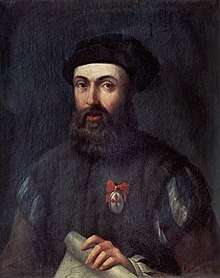History of the Philippines (900–1565)
The history of the Philippines between 900 and 1565 begins with the creation of the Laguna Copperplate Inscription in 900 and ends with Spanish colonisation in 1565. The inscription records its date of creation in the year 822 of the Hindu Saka calendar, corresponding to 900 AD in the Gregorian system. Therefore, the recovery of this document marks the end of prehistory of the Philippines at 900 AD. During this historical time period, the Philippine archipelago was home to numerous kingdoms and sultanates and was a part of the theorised Indosphere and Sinosphere.[1][2][3][4]
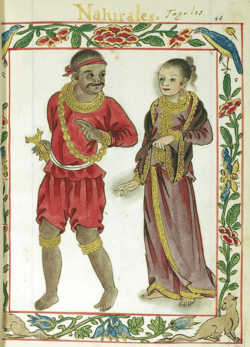 | |
| Horizon | Philippine history |
|---|---|
| Geographical range | Southeast Asia |
| Period | c.900–1560s |
| Dates | c. Before 900 AD |
| Major sites | Tundun, Seludong, Pangasinan, Limestone tombs, Idjang citadels, Panay, Rajahnate of Cebu, Rajahnate of Butuan, Kota Wato, Kota Sug, Ma-i, Dapitan, Gold artifacts, Singhapala, Ifugao plutocracy |
| Characteristics | Indianized kingdoms, Hindu and Buddhist Nations, Islamized Indianized sultanates Sinicized Nations |
| Preceded by | Prehistory of the Philippines |
| Followed by | Colonial era |
Sources of precolonial history include archeological findings, records from contact with the Song Dynasty, the Bruneian Empire, Japan, and Muslim traders, the genealogical records of Muslim rulers, accounts written by Spanish chroniclers in the 16th and 17th century, and cultural patterns which at the time had not yet been replaced through European influence.
Laguna Copperplate Inscription
Decipherment
In January 1990, the Laguna Copperplate Inscription, then just a thin sheet of crumpled and blackened metal, was bought and acquired by the National Museum of the Philippines after previous efforts to sell it as an antique had been unsuccessful.
It measures around 20 cm by 30 cm and is inscribed with ten lines of writing on one side. The text was mostly written in Old Malay with influences of Sanskrit, Old Javanese and Old Tagalog using the Kawi script. Dutch anthropologist Antoon Postma deciphered the text and found that it identified the date of its inscription in the "Year of Saka 822, month of Vaisakha." This corresponds with months April-May in the year 900 AD of the Gregorian calendar.
Contents
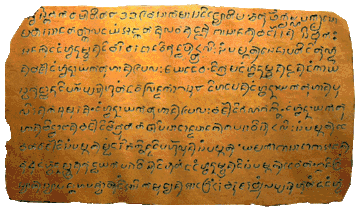
The document states the acquittal of all the descendants of a certain honourable Namwaran from a debt of 1 kati and 8 suwarna, which is equivalent to 926.4 grams of gold granted by the Military Commander of Tundun (Tondo) and witnessed by the leaders of Pailah, Binwangan and Puliran, which are places likely to be also located in Luzon.
The reference to the contemporaneous Medang Kingdom in modern-day Indonesia imply political connections with territories elsewhere in the Maritime Southeast Asia.
This document is the earliest record of a Philippine language and the presence of writing in the islands. Its contents also suggest the existence of political dominion and long-distance trade in the Philippine archipelago in as early as the 9th century.
Politics
City-states
Communities of various ethnic groups in the archipelago established city-states often governed by a raja or a lakan. These city-states were formed by assimilating small political units known as barangay that were each led by a datu. Each barangay consisted of about a hundred families.
Social classes
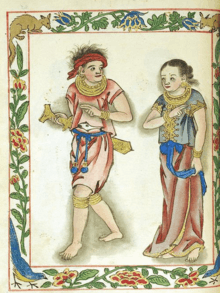
By the 15th century, the city-states in the Philippine archipelago were organized in strict social classes as follows:
Other polity systems by ethnic group
In Luzon
In the Cagayan Valley, the head of the Ilongot city-states was called a benganganat, while for the Gaddang it was called a mingal.[7][8][9]
The Ilocano people in northwestern Luzon were originally located in modern-day Ilocos Sur and were led by a babacnang. Their polity was called Samtoy which did not have a royal family but was headed as a chieftaincy.
The people of the Cordilleras, collectively known by the Spanish as Igorot, were headed by an apo. These civilizations were highland plutocracies with distinct cultures where most were headhunters. According to literature, some Igorot people were always at war with the lowland Ilocano people from the west.[10][11]
In Mindanao
The Lumad people from inland Mindanao are known to have been headed by a datu.
The Subanon people in the Zamboanga Peninsula were ruled by a timuay until they were overcame by the Sultanate of Sulu in the 13th century.
The Sama-Bajau people in Sulu who were not Muslims nor affiliated with the Sultanate of Sulu were ruled by a nakurah before the arrival of Islam.
Indian influence
Writing systems
Brahmic scripts were introduced in Maritime Southeast Asia through Indian influence. This led to the creation and use of the Kawi script and several native writing systems in the Philippine archipelago.[12]
Kawi script
The Laguna Copperplate Inscription was written using the Kawi script which originated in Java and was used across Maritime Southeast Asia.
Baybayin script
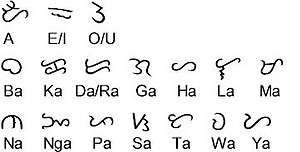
By the 13th or 14th century, the Baybayin script was in use for the Tagalog language. It is known to have spread to Luzon, Mindoro, Palawan, Panay and Leyte, but there is no proof that it was used in Mindanao.
There were at least three varieties of the Baybayin script in the late 16th century. These are comparable to the different variations of the Latin script in Europe which use slightly different sets of letters and spelling systems.[13]
In 1521, the chronicler Antonio Pigafetta from the expedition of Ferdinand Magellan noted that the people that they met in Visayas were not literate. However, in the next few decades the Baybayin script seemed to have been introduced to them. In 1567 Miguel López de Legaspi reported that "they [the Visayans] have their letters and characters like those of the Malays, from whom they learned them; they write them on bamboo bark and palm leaves with a pointed tool, but never is any ancient writing found among them nor word of their origin and arrival in these islands, their customs and rites being preserved by traditions handed down from father to son without any other record."[14]
Earliest documented Chinese contact
The earliest date suggested for direct Chinese contact with the Philippines was 982. At the time, merchants from "Ma-i" (now thought to be either Bay, Laguna on the shores of Laguna de Bay,[15] or a site called "Mait" in Mindoro[16][17]) brought their wares to Guangzhou and Quanzhou. This was mentioned in the History of Song and Wenxian Tongkao by Ma Duanlin which were authored during the Yuan Dynasty.[16]
Arrival of Islam

Beginnings
Muslim traders introduced Islam to the then-Indianised Malayan empires around the time that wars over succession had ended in the Majapahit Empire in 1405. However, Makhdum Karim had already brought Islam to the Philippine archipelago in 1380, establishing the Sheik Karimal Makdum Mosque in Simunul, Tawi-Tawi, the oldest mosque in the country. Subsequent visits by Arab, Malay and Javanese missionaries helped spread Islam further in the islands.
The Sultanate of Sulu once encompassed parts of modern-day Indonesia, Malaysia and the Philippines. Its royal house also claims descent from Muhammad.
Bruneian attacks
.png)
Early in the 16th century, the Bruneian Empire under Sultan Bolkiah attacked the Kingdom of Tondo.[1][18] Thus until the arrival of the Spanish, southern parts of Luzon and some islands further south have been at least nominally influenced by Islam.
Spanish expeditions
The following table shows some important details about the expeditions made by the Spanish to the Philippine archipelago.
| Year | Leader | Ships | Landing |
|---|---|---|---|
| 1521 | Trinidad, San Antonio, Concepcion, Santiago and Victoria | Homonhon, Limasawa, Cebu | |
| 1525 | Santa María de la Victoria, Espiritu Santo, Anunciada, San Gabriel, Jayson Ponce, Santa María del Parral, San Lesmes and Santiago | Surigao, Visayas, Mindanao | |
| 1527 | 3 unknown ships | Mindanao | |
| 1542 | Santiago, Jorge, San Antonio, San Cristóbal, San Martín, and San Juan | Samar, Leyte, Saranggani | |
| 1564 | San Pedro, San Pablo, San Juan and San Lucas | first landed on Samar, established colonies as part of Spanish Empire |
First expedition
After the Portuguese reached the Maluku Islands in 1511, the earliest documented European expedition to the Philippine archipelago was led by the Portuguese navigator Ferdinand Magellan in the service of King Charles V of Spain in 1521.
Magellan's expedition first arrived at the island of Homonhon at the mouth of the Leyte Gulf on 16 March 1521.[19] On Easter Sunday, 31 March 1521, in the island of Mazaua (Limasawa), Magellan solemnly planted a cross on the top of a hill overlooking the sea and claimed for the King of Spain the possession of the islands he had encountered, naming them Archipelago of Saint Lazarus as stated in "First Voyage Around The World" by one of his companions, the chronicler Antonio Pigafetta .[20]
Magellan sought alliances among the people in the islands beginning with Datu Zula of Sugbu (Cebu), and took special pride in converting them to Christianity. Magellan got involved in the political conflicts in the islands and took part in a battle against Lapulapu, chief of Mactan and an enemy of Datu Zula.
At dawn on 27 April 1521, the Battle of Mactan occurred. Magellan with 60 armed men and 1,000 Visayan warriors had great difficulty landing on the rocky shore of Mactan where Lapulapu had an army of 1,500 waiting on land. Magellan waded ashore with his soldiers and attacked Lapulapu's forces, telling Datu Zula and his warriors to remain on the ships and watch. Magellan underestimated the army of Lapulapu, and, grossly outnumbered, Magellan and 14 of his soldiers were killed. The rest managed to reboard the ships.
The battle left the expedition with too few crewmen to man three ships, so they abandoned the "Concepción". The remaining ships – "Trinidad" and "Victoria" – sailed to the Spice Islands in present-day Indonesia. From there, the expedition split into two groups. The Trinidad, commanded by Gonzalo Gómez de Espinoza tried to sail eastward across the Pacific Ocean to the Isthmus of Panama. Disease and shipwreck disrupted Espinoza's voyage and most of the crew died. Survivors of the Trinidad returned to the Spice Islands, where the Portuguese imprisoned them. The Victoria continued sailing westward, commanded by Juan Sebastián Elcano, and managed to return to Sanlúcar de Barrameda, Spain in 1522.
Subsequent expeditions
After Magellan's expedition, four more expeditions were made to the islands. These were led by García Jofre de Loaísa in 1525, Sebastian Cabot in 1526, Álvaro de Saavedra Cerón in 1527, and Ruy López de Villalobos in 1542.[21].
In 1543, Villalobos named the islands of Leyte and Samar Las Islas Filipinas in honor of Philip II of Spain, at the time Prince of Asturias.[22]
Conquest of the islands
Philip II became King of Spain on January 16, 1556 when his father, Charles V), abdicated the Spanish throne. In his return to Spain in 1559, the king ordered an expedition mounted to the Spice Islands, stating that its purpose was "to discover the islands of the west".[23] In reality its task was to conquer the Philippine islands for Spain.[24]
On November 19 or 20, 1564 a Spanish expedition of a mere 500 men led by Miguel López de Legazpi departed Barra de Navidad, New Spain, arriving at Cebu on February 13, 1565.[25] It was after this expedition that the first Spanish settlements, the Captaincy General of the Philippines and the Spanish East Indies were established.
The Legazpi expedition was successful as it established the first colony in the Philippines. It also resulted in the discovery of the tornaviaje return route to Mexico across the Pacific by Andrés de Urdaneta.[26] This discovery started the Manila galleon trade, which lasted for two and a half centuries.
See also
- Antonio de Morga
- Anito
- Antonio Pigafetta
- Philippine shamans
- Barangay (pre-colonial)
- Baybayin
- Boxer Codex
- Cainta (historical polity)
- Huangdom of Pangasinan
- Dambana
- Datu
- Enrique of Malacca
- Ferdinand Magellan
- First Mass in the Philippines
- Kingdom of Tondo
- Lakan
- Lacandola Documents
- Lapulapu
- List of sovereign state leaders in the Philippines
- Luções
- Ma-i
- Madja-as
- Maginoo
- Maharlika
- Pintados
- Rajah Humabon
- Rajahnate of Butuan
- Rajahnate of Cebu
- Sultanates in Lanao
- Rajahnate of Maynila
- Sultanate of Maguindanao
- Sultanate of Sulu
- Suyat
- Timawa
- Warfare in pre-colonial Philippines
- Thimuay
- Subanon people
- Rajah
- Tawalisi
- History of the Philippines
- Prehistory of the Philippines
- History of the Philippines (Spanish Era 1521–1898)
- History of the Philippines (American Era 1898–1946)
- History of the Philippines (Third Republic 1946–65)
- History of the Philippines (Marcos Era 1965–86)
- History of the Philippines (Contemporary Era 1986–present)
Notes
References
-
- Scott, William Henry (1994). Barangay: Sixteenth Century Philippine Culture and Society. Quezon City: Ateneo de Manila University Press. ISBN 971-550-135-4.
- "Philippines | The Ancient Web". theancientweb.com. Retrieved March 4, 2016.
- Scott, William Henry (1992), Looking for the Prehispanic Filipino. New Day Publishers, Quezon City. 172pp. ISBN 9711005247.
- Patricia Herbert; Anthony Crothers Milner (1989). South-East Asia: Languages and Literatures : a Select Guide. University of Hawaii Press. p. 153. ISBN 978-0-8248-1267-6.
- Scott, William Henry (1992). Looking for the Prehispanic Filipino.. p. 2.
- Woods, Damon L. (1992). "Tomas Pinpin and the Literate Indio: Tagalog Writing in the Early Spanish Philippines" (PDF). Cite journal requires
|journal=(help) - "The Islands of Leyte and Samar – National Commission for Culture and the Arts".
- "ILONGOT – National Commission for Culture and the Arts".
- "GLIMPSES: Peoples of the Philippines".
- "Politico-Diplomatic History of the Philippines – National Commission for Culture and the Arts".
- "Biag ni Lam-ang: Summary / Buod ng Biag ni Lam-ang". August 28, 2017.
- Baybayin, the Ancient Philippine script Archived August 8, 2010, at WebCite. Accessed September 4, 2008.
- Morrow, Paul. "Baybayin Styles & Their Sources". Retrieved April 25, 2020.
- de San Agustin, Caspar (1646). Conquista de las Islas Filipinas 1565-1615.
'Tienen sus letras y caracteres como los malayos, de quien los aprendieron; con ellos escriben con unos punzones en cortezas de caña y hojas de palmas, pero nunca se les halló escritura antinua alguna ni luz de su orgen y venida a estas islas, conservando sus costumbres y ritos por tradición de padres a hijos din otra noticia alguna.'
- Go, Bon Juan (2005). "Ma'l in Chinese Records – Mindoro or Bai? An Examination of a Historical Puzzle". Philippine Studies. Quezon City: Ateneo de Manila University. 53 (1): 119–138. Retrieved October 16, 2012.
- Patanne, E. P. (1996). The Philippines in the 6th to 16th Centuries. San Juan: LSA Press. ISBN 971-91666-0-6.
- Scott, William Henry. (1984). "Societies in Prehispanic Philippines". Prehispanic Source Materials for the Study of Philippine History. Quezon City: New Day Publishers. p. 70. ISBN 971-10-0226-4.
- del Mundo, Clodualdo (September 20, 1999). "Ako'y Si Ragam (I am Ragam)". Diwang Kayumanggi. Archived from the original on October 25, 2009. Retrieved September 30, 2008.
- Zaide 2006, p. 78
- Zaide 2006, pp. 80–81
- Zaide 2006, pp. 86–87.
- Scott 1985, p. 51.
- Williams 2009, p. 14
- Williams 2009, pp. 13–33.
- M.c. Halili (2004). Philippine History' 2004 Ed.-halili. Rex Bookstore, Inc. ISBN 978-971-23-3934-9.
- Zaide 1939, p. 113
Further reading
- Scott, William Henry. (1984). Prehispanic Source Materials for the Study of Philippine History (Revised Edition). New Day Publishers, Quezon City. ISBN 9711002264.

.svg.png)
